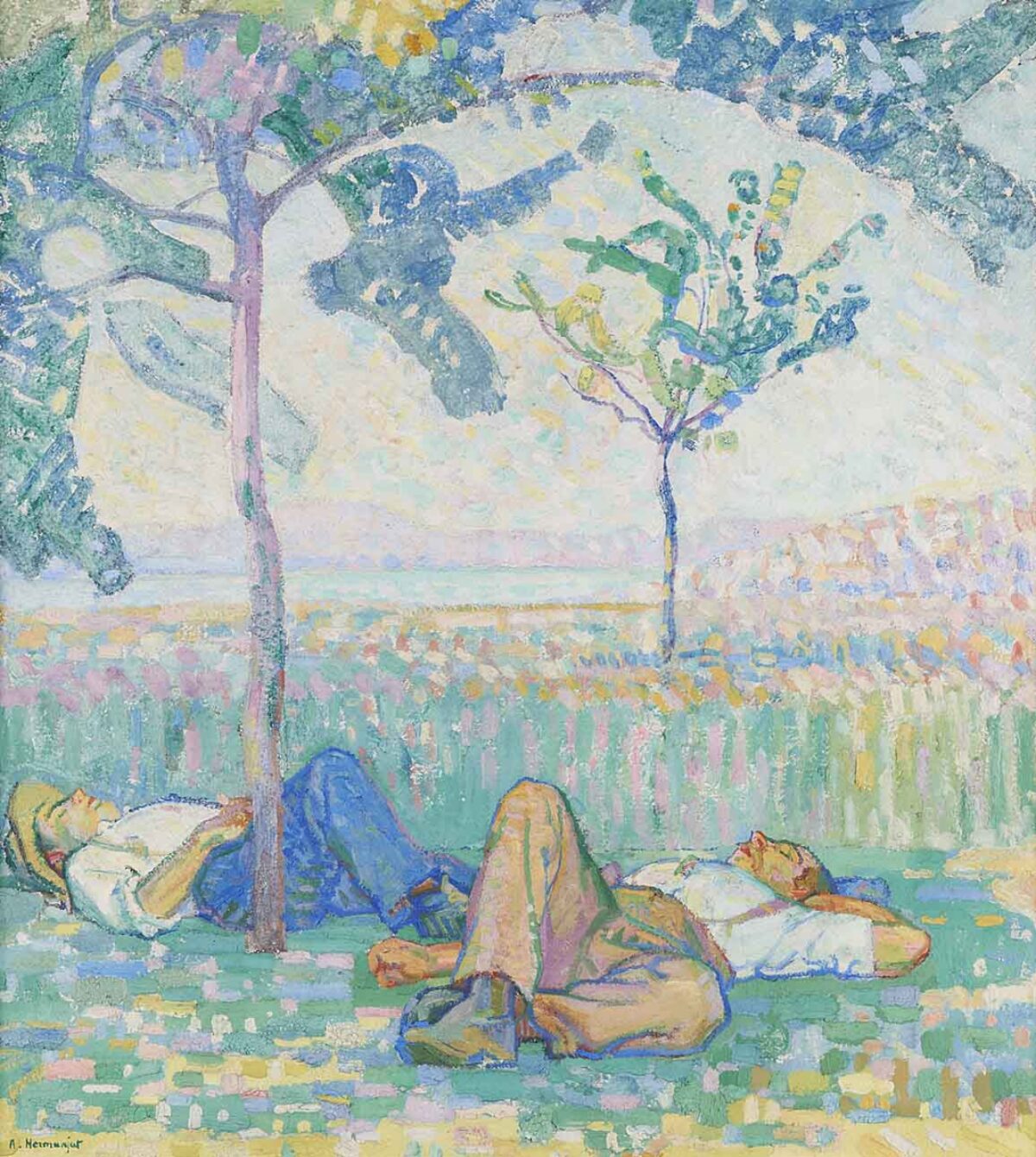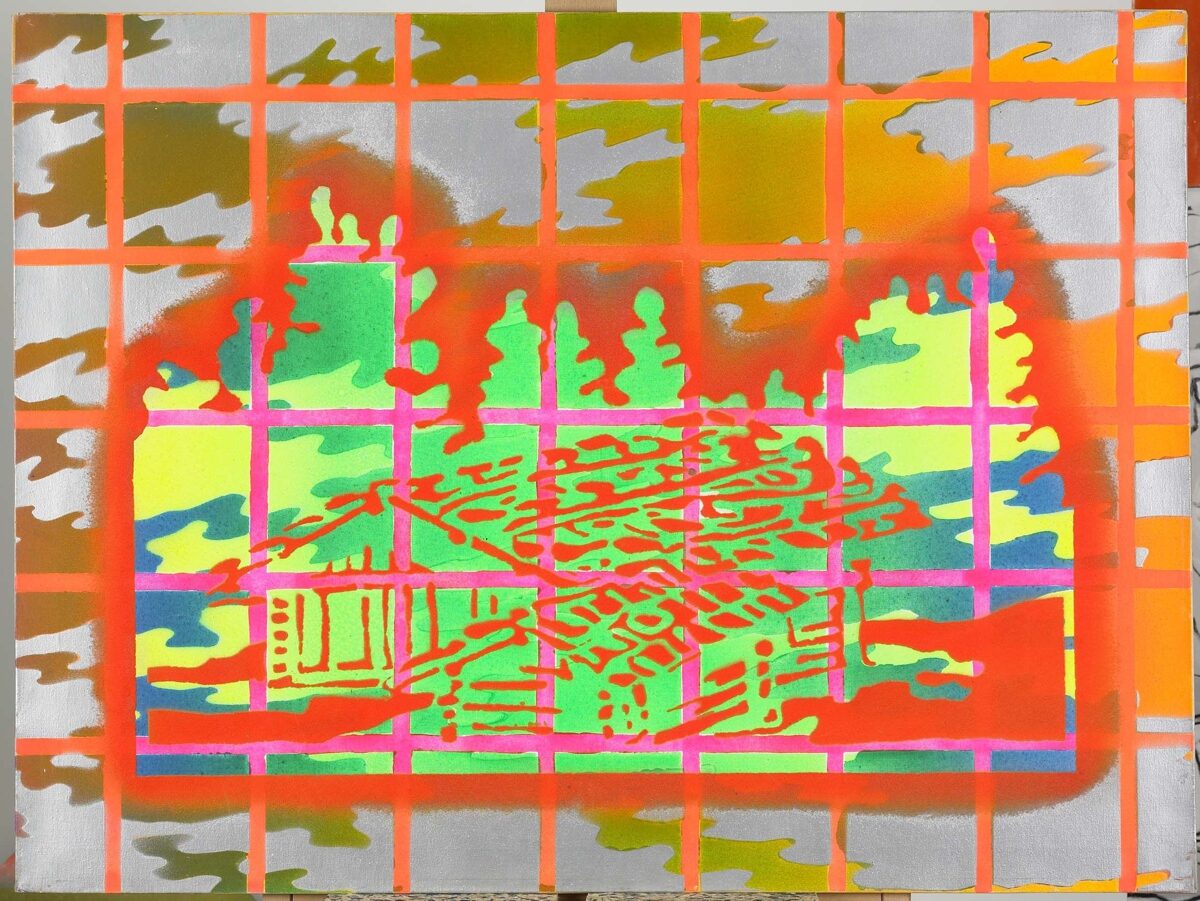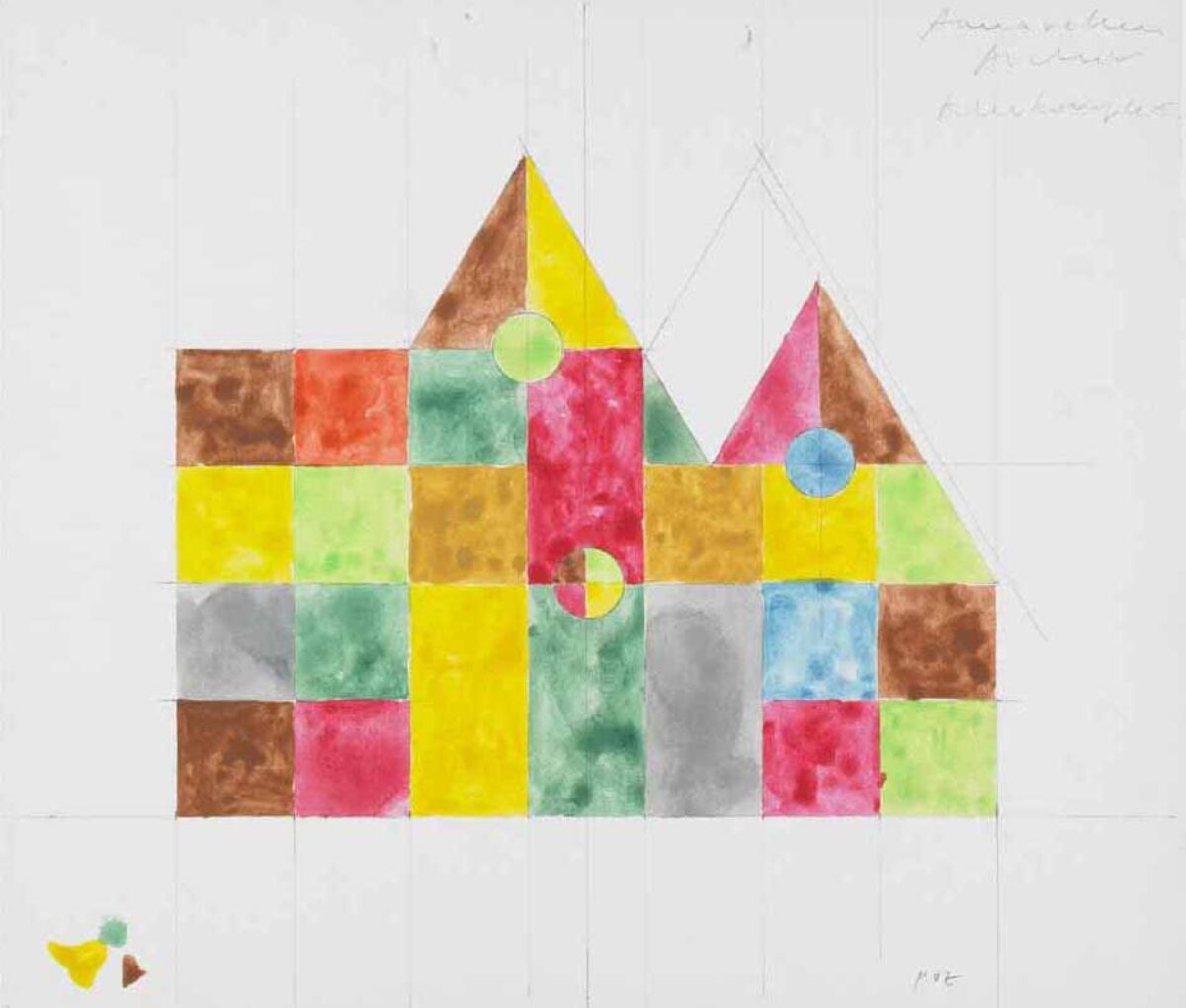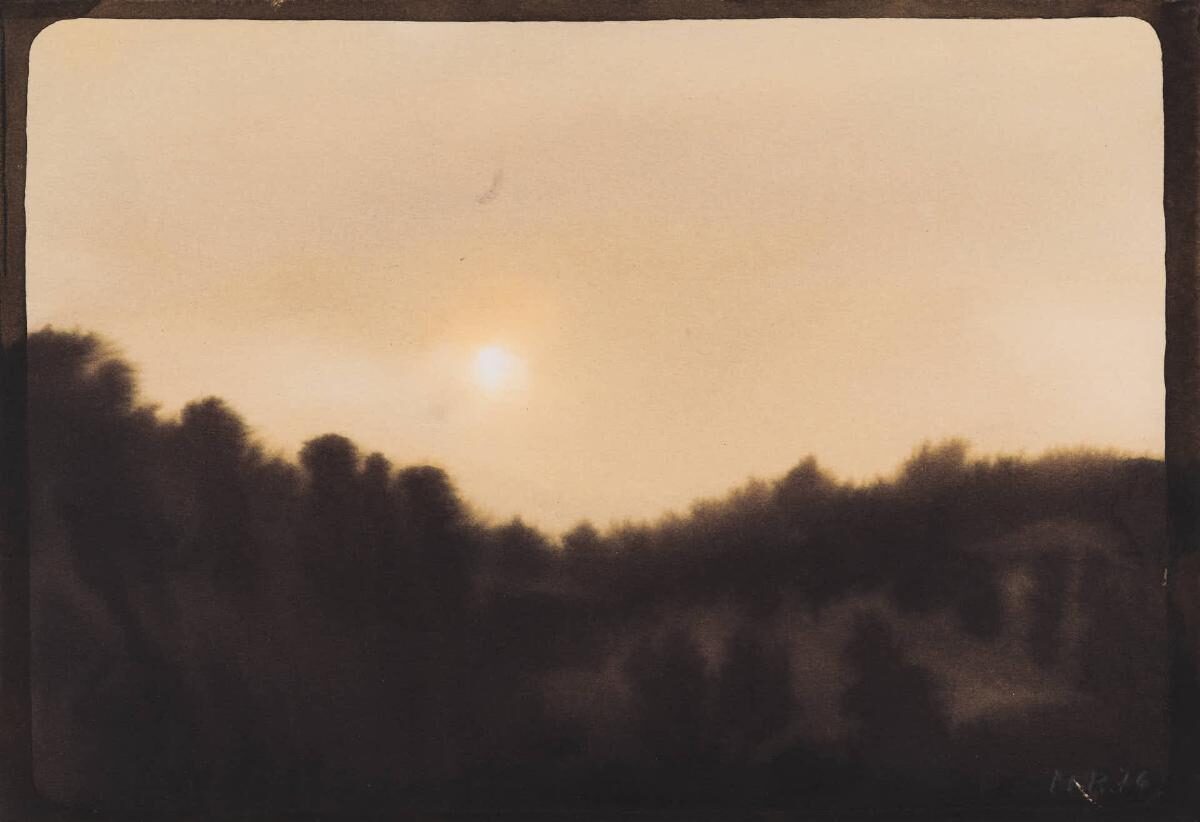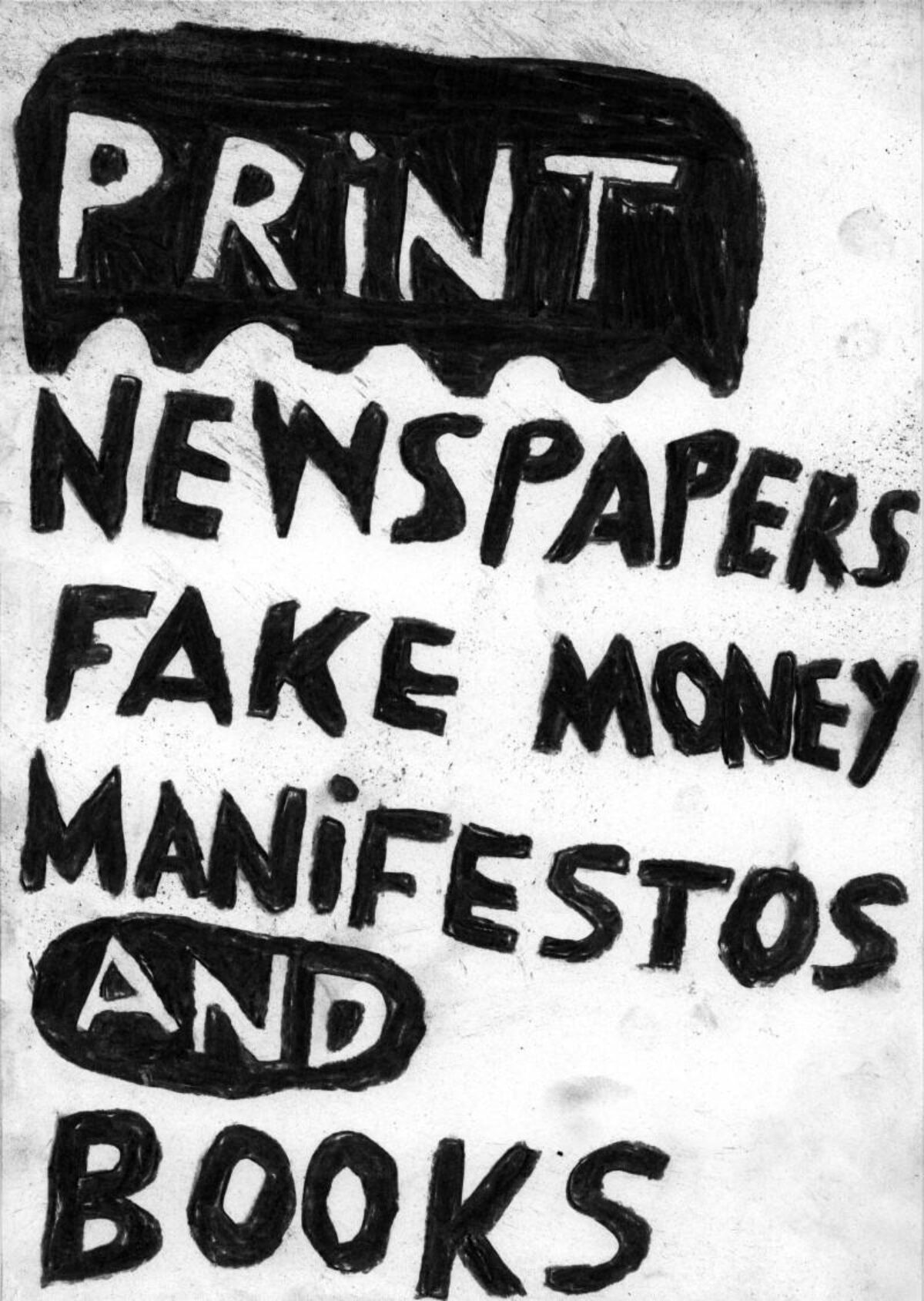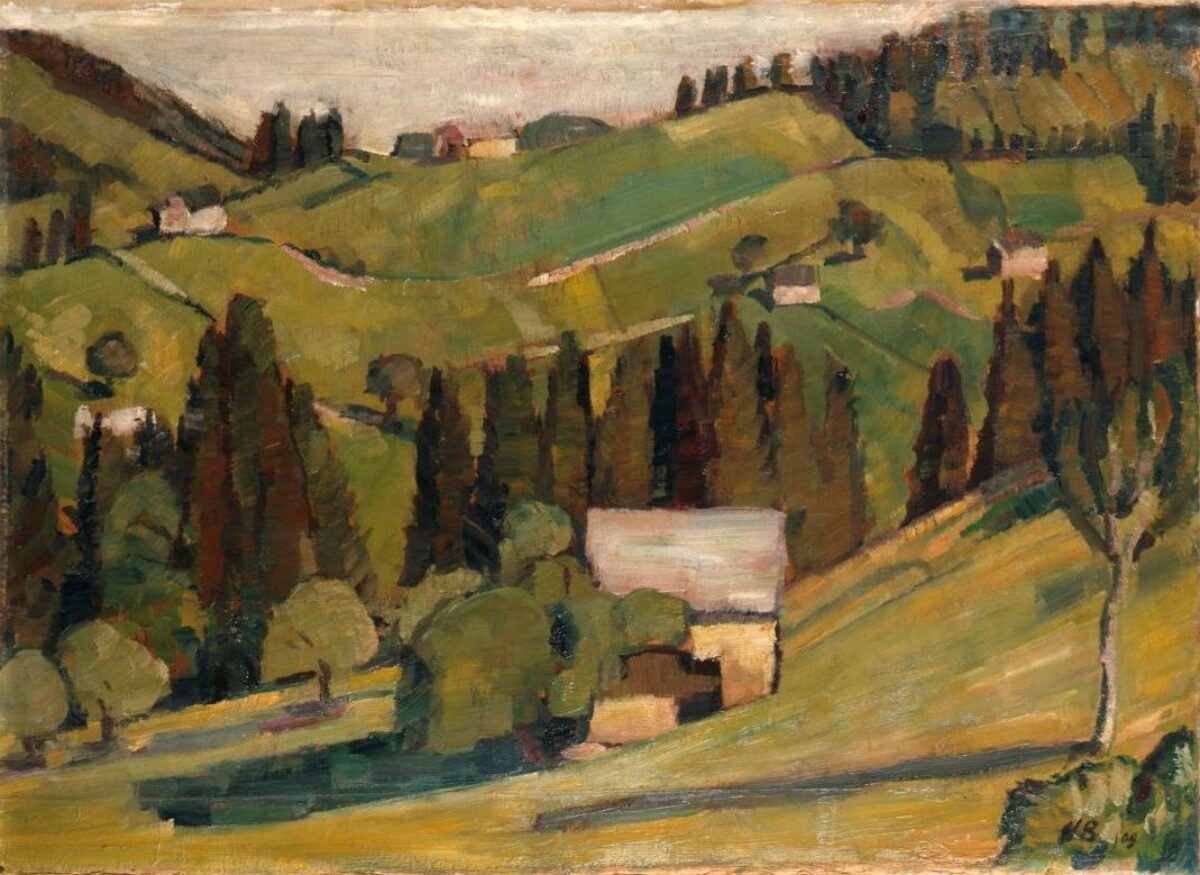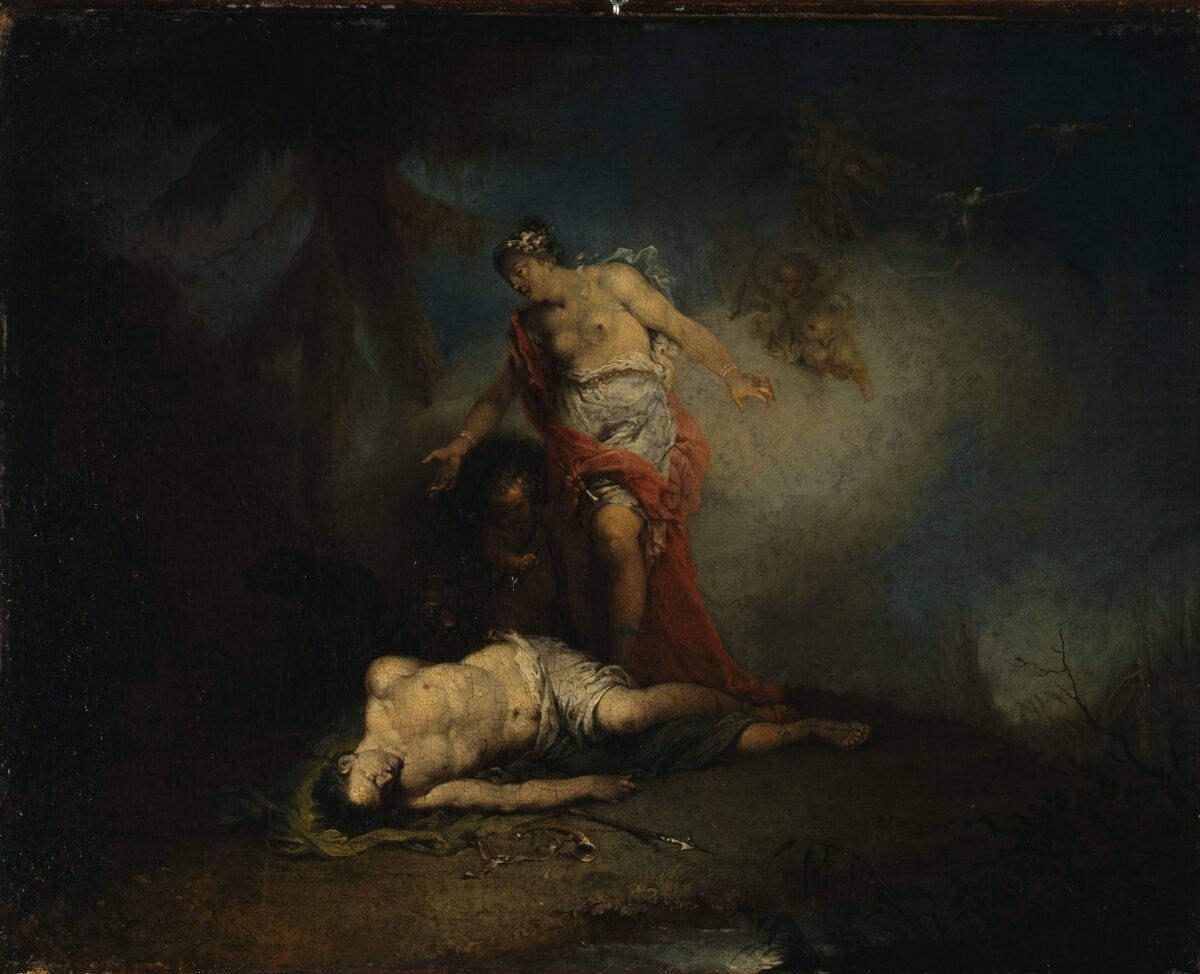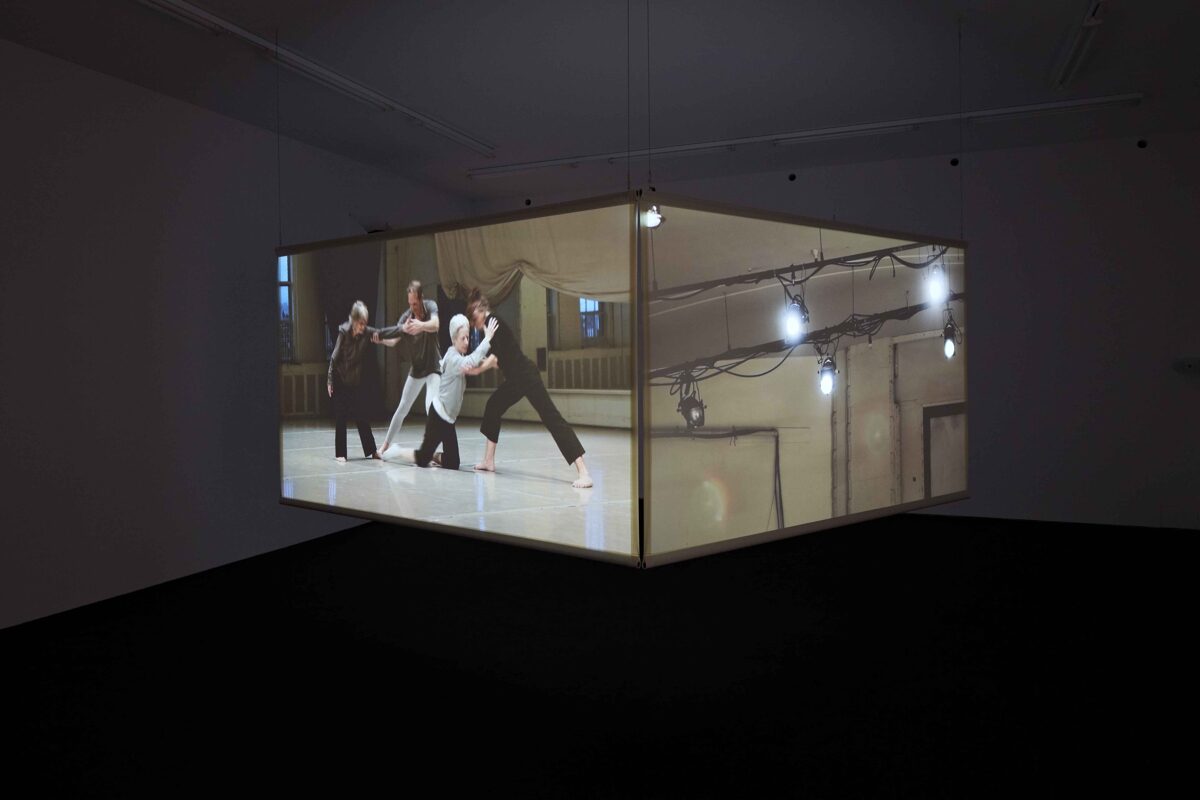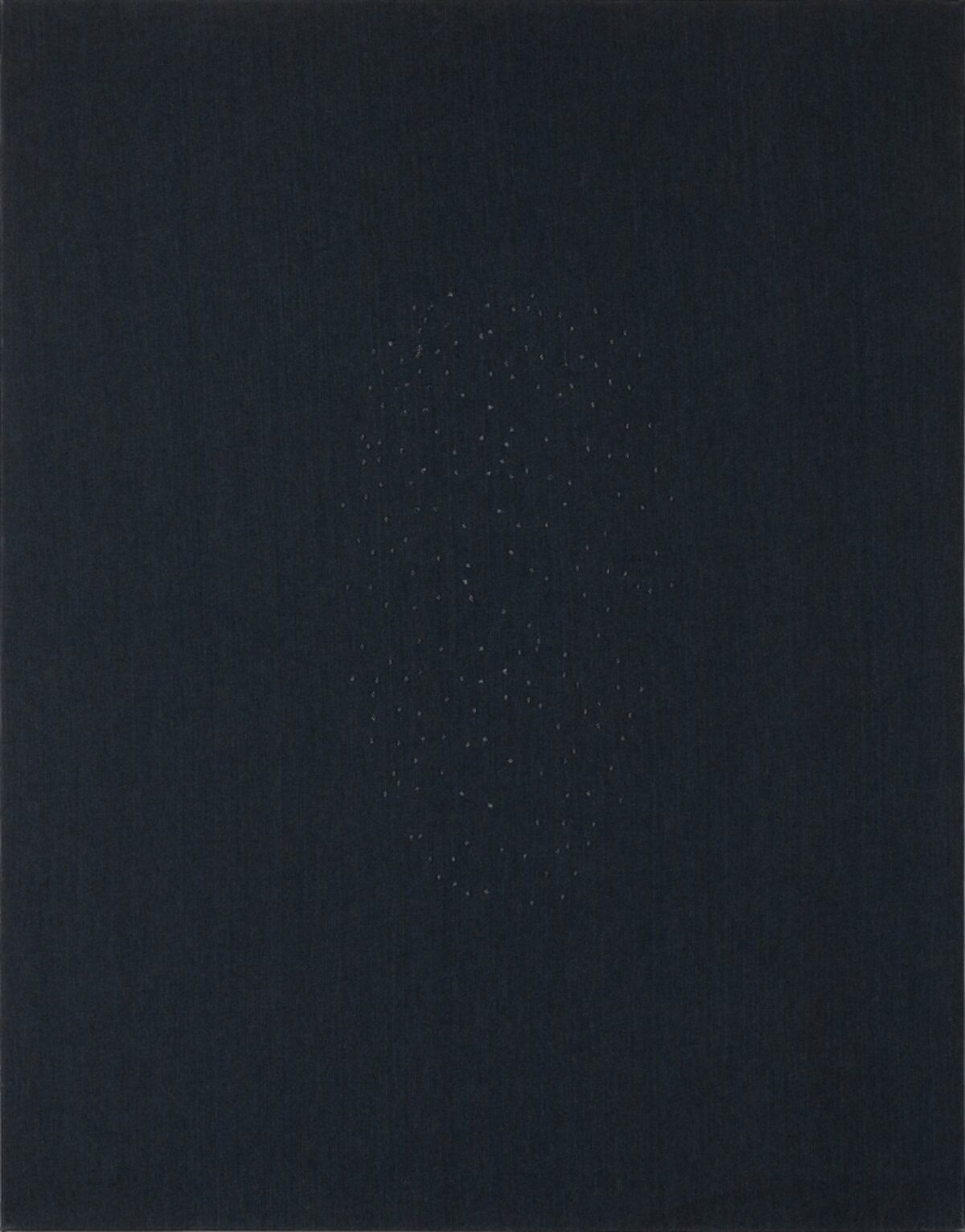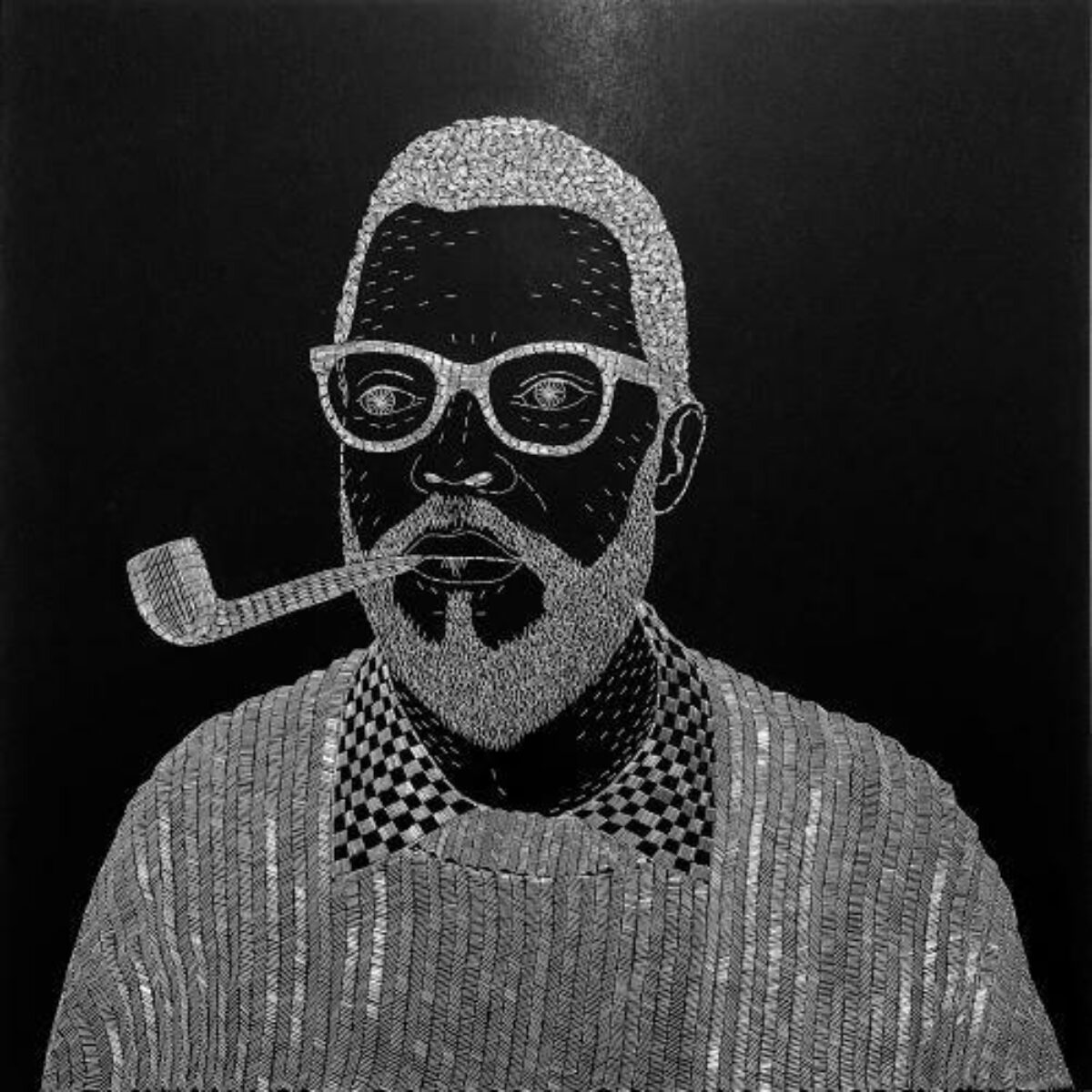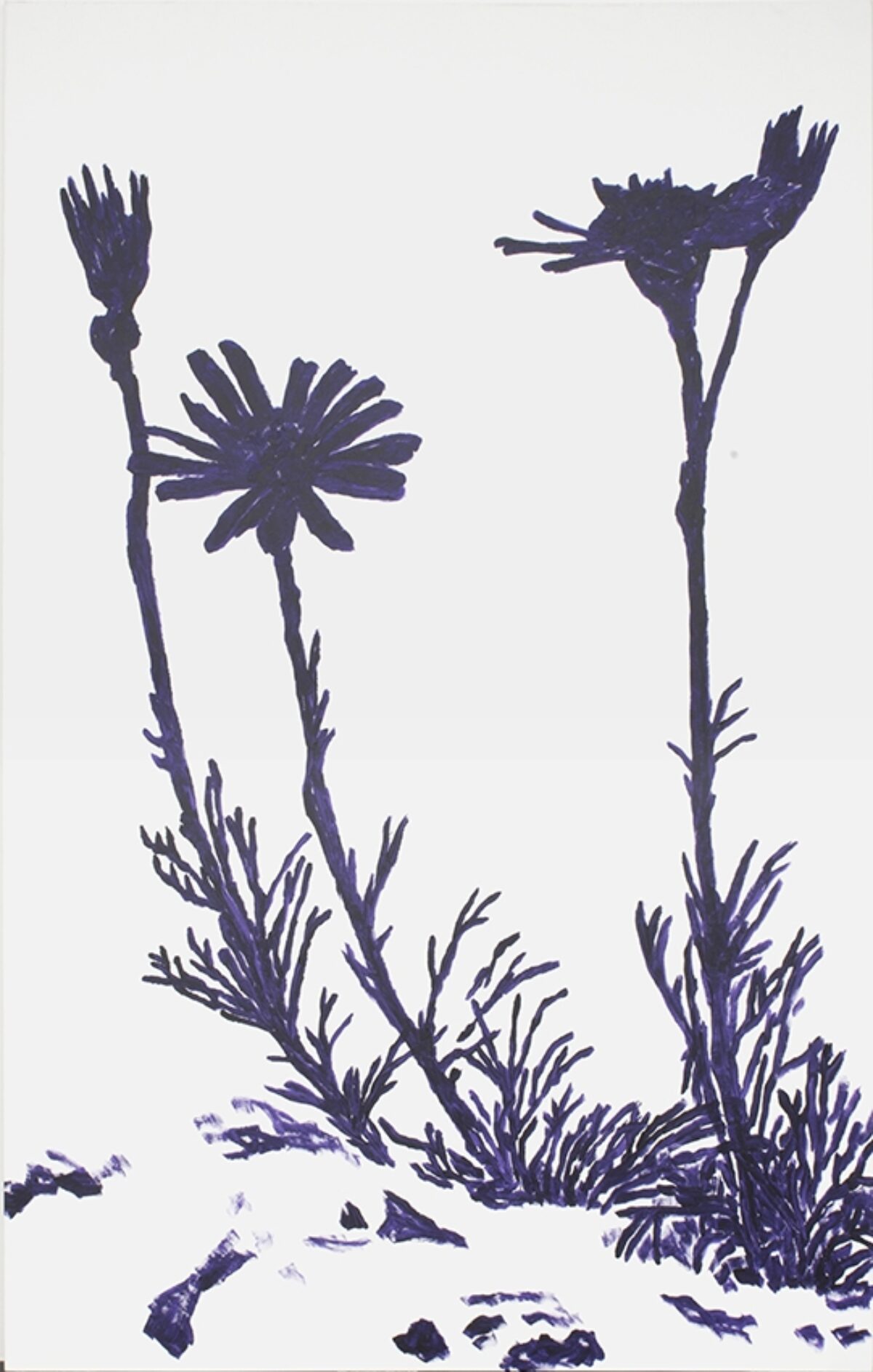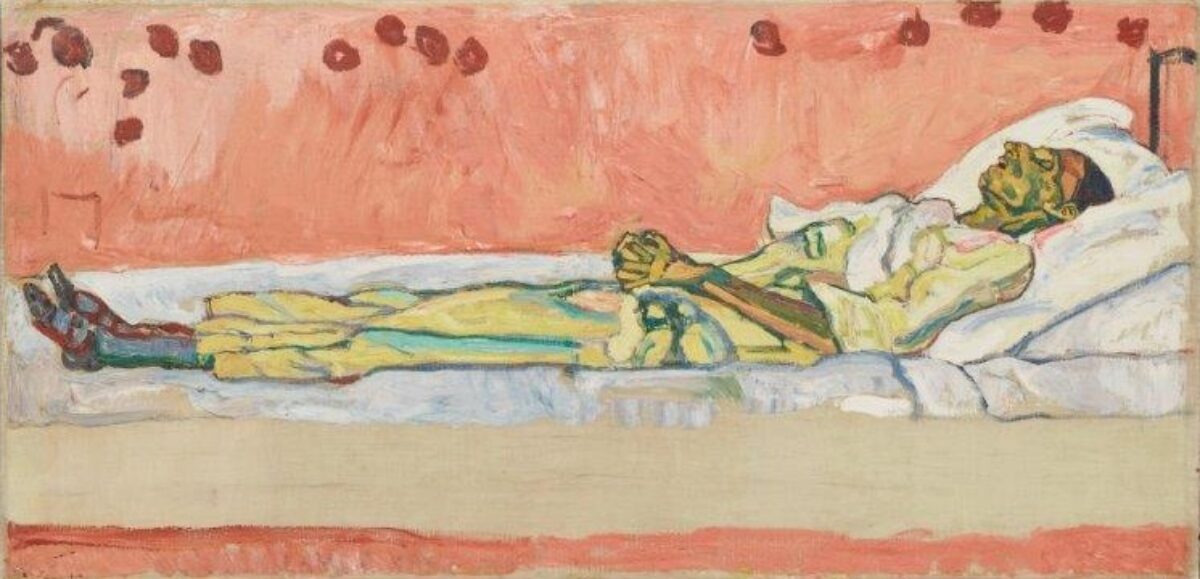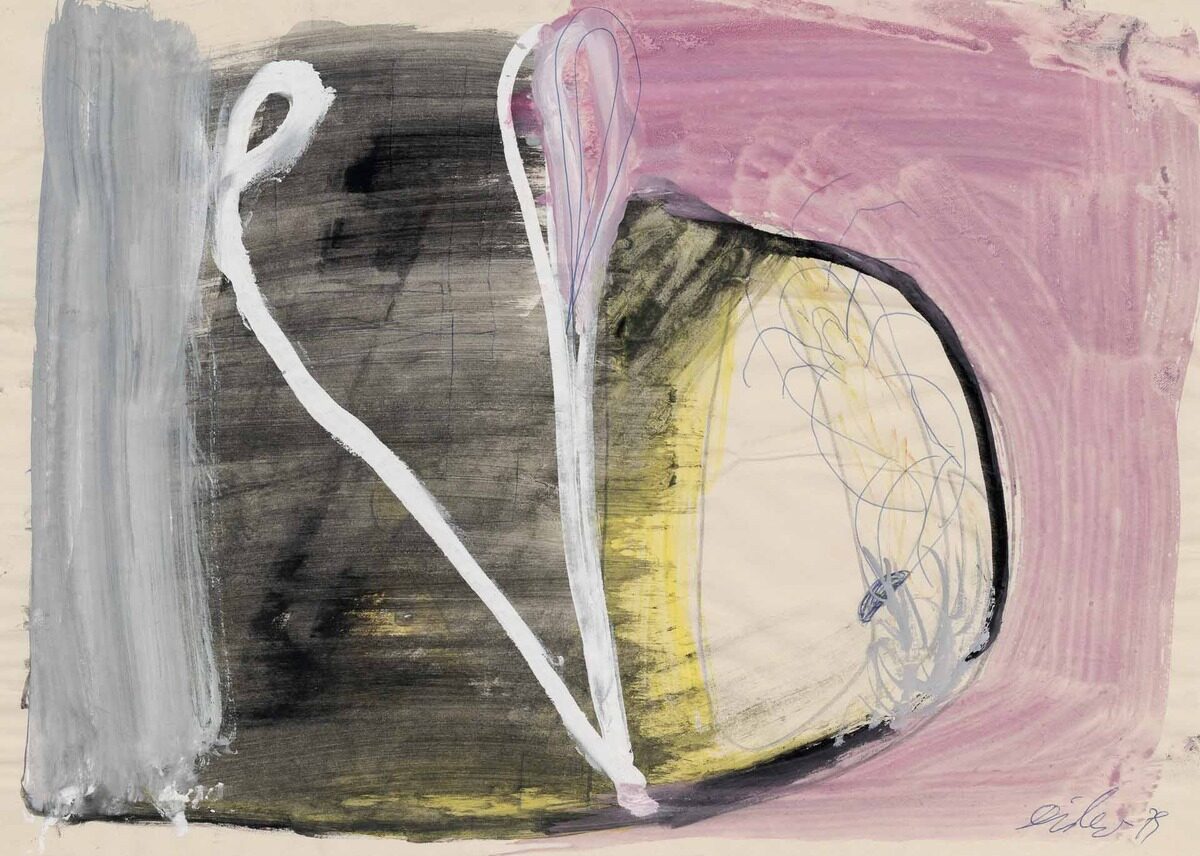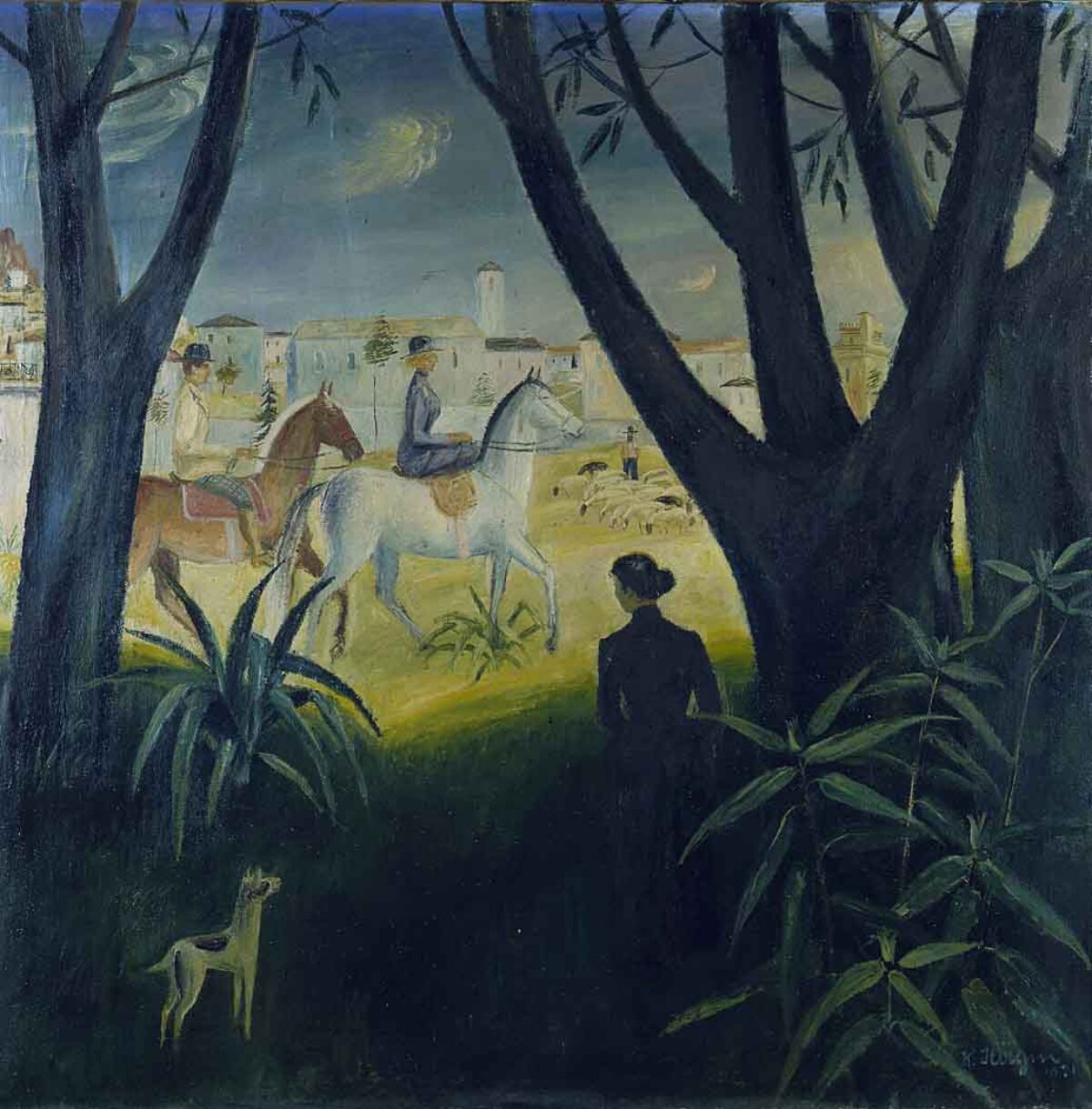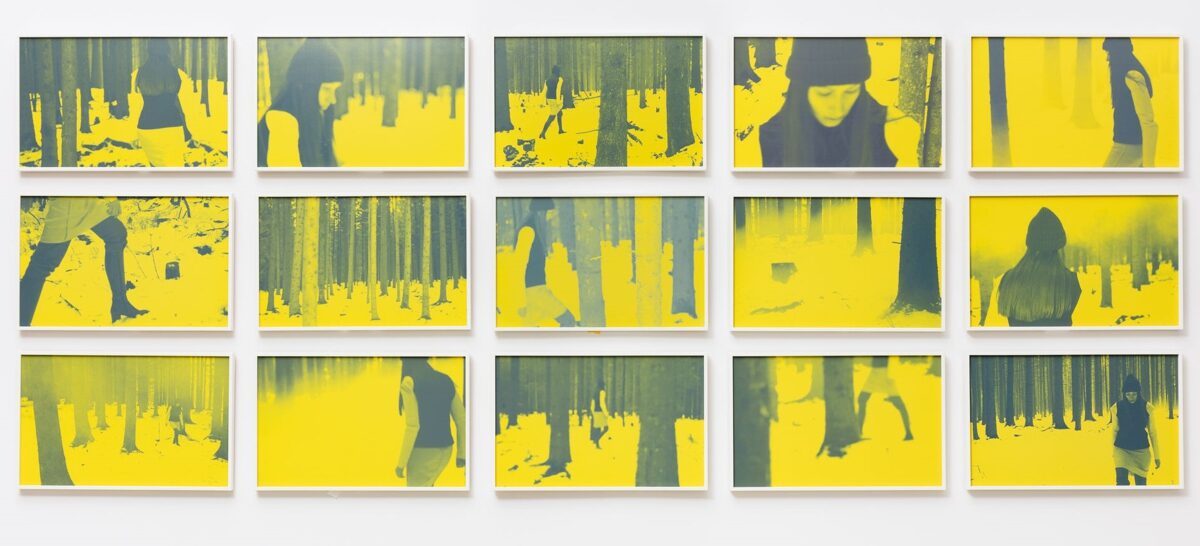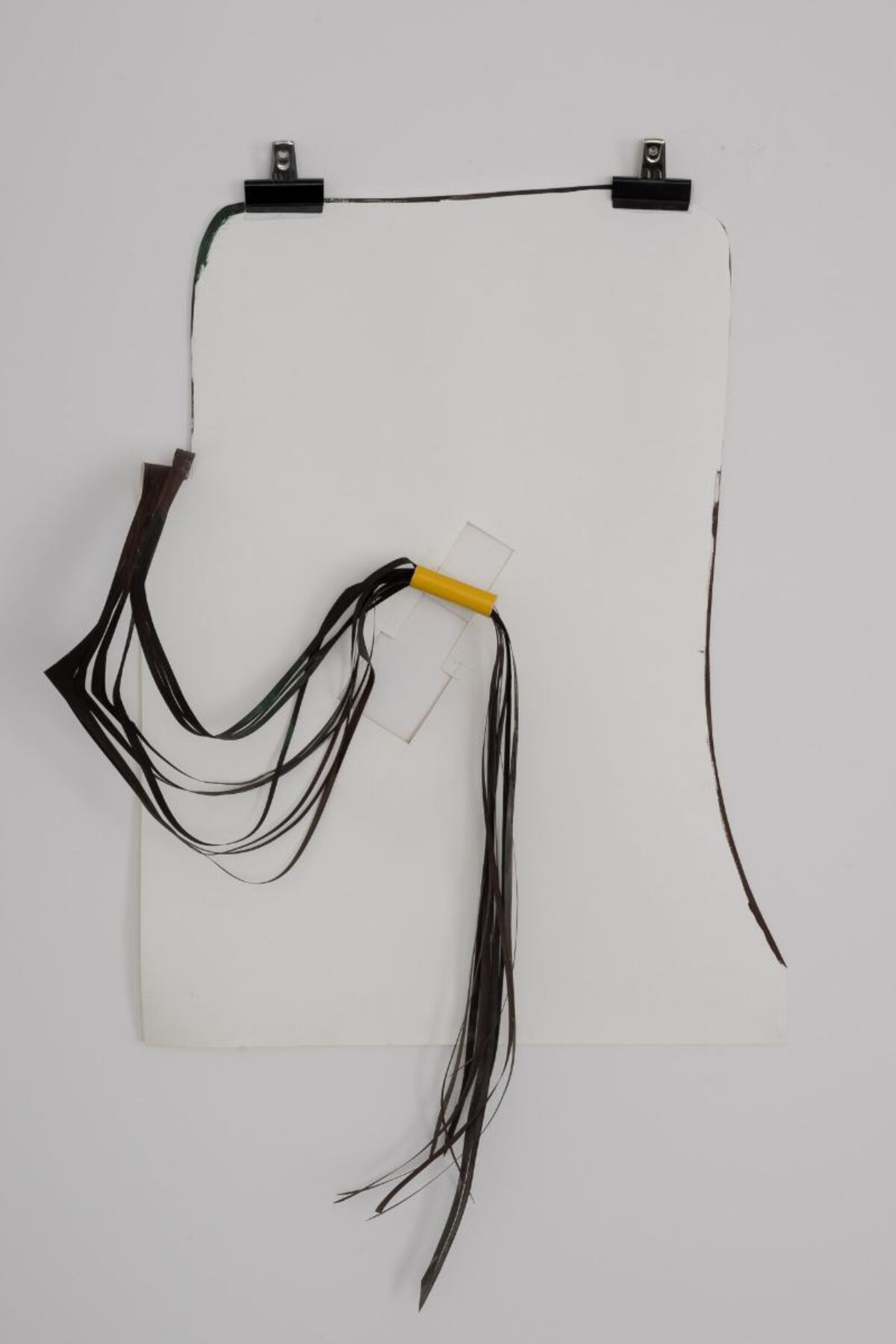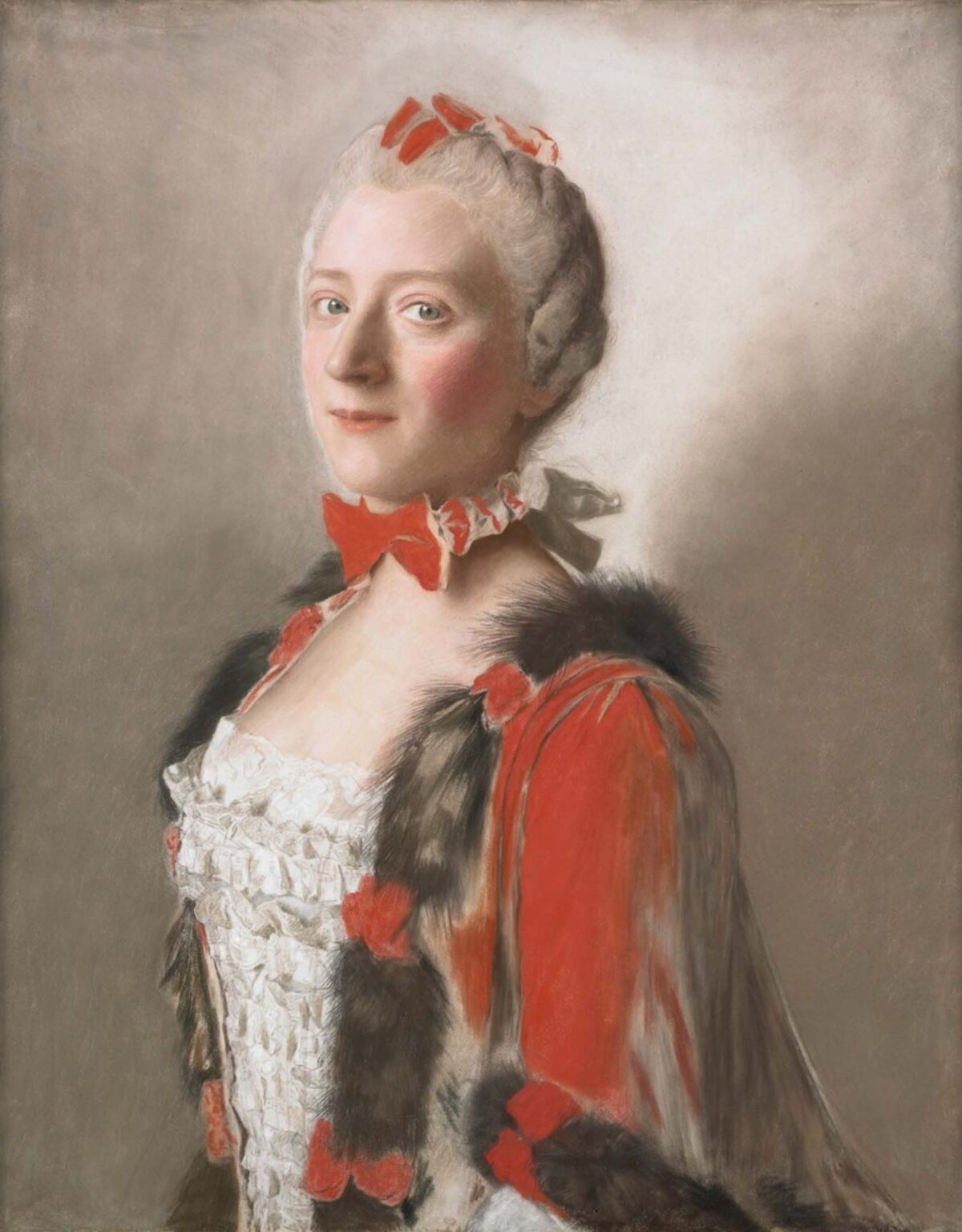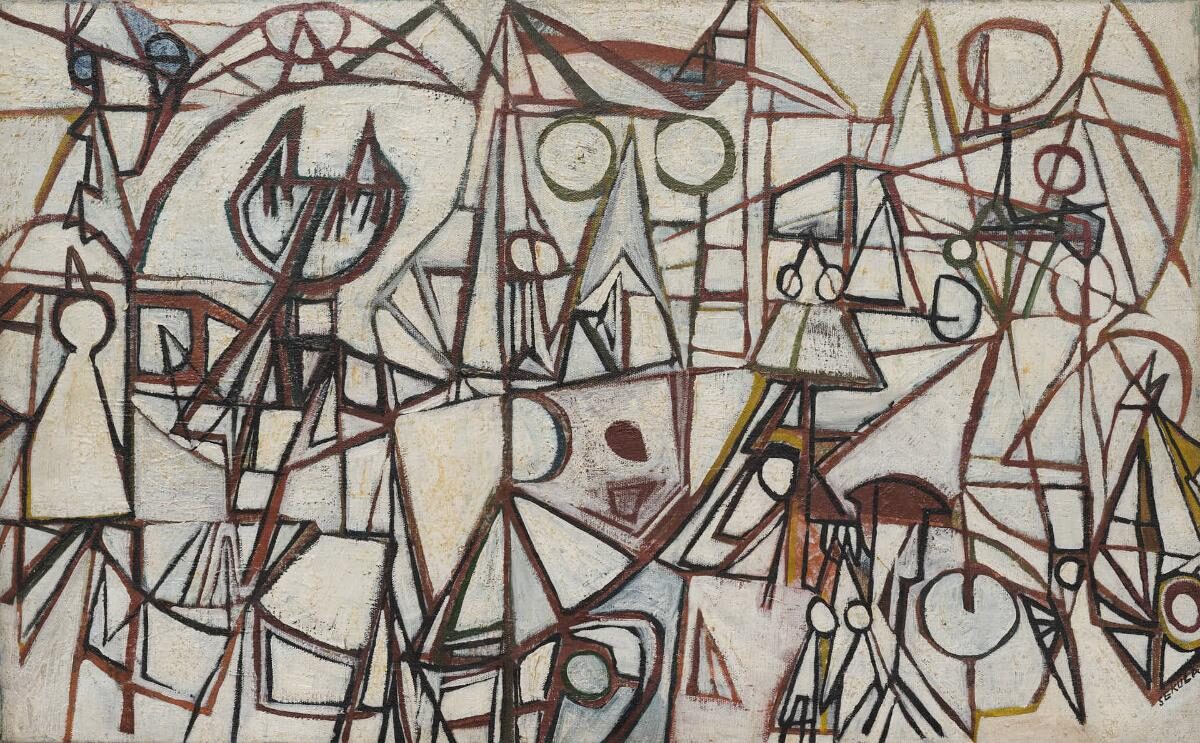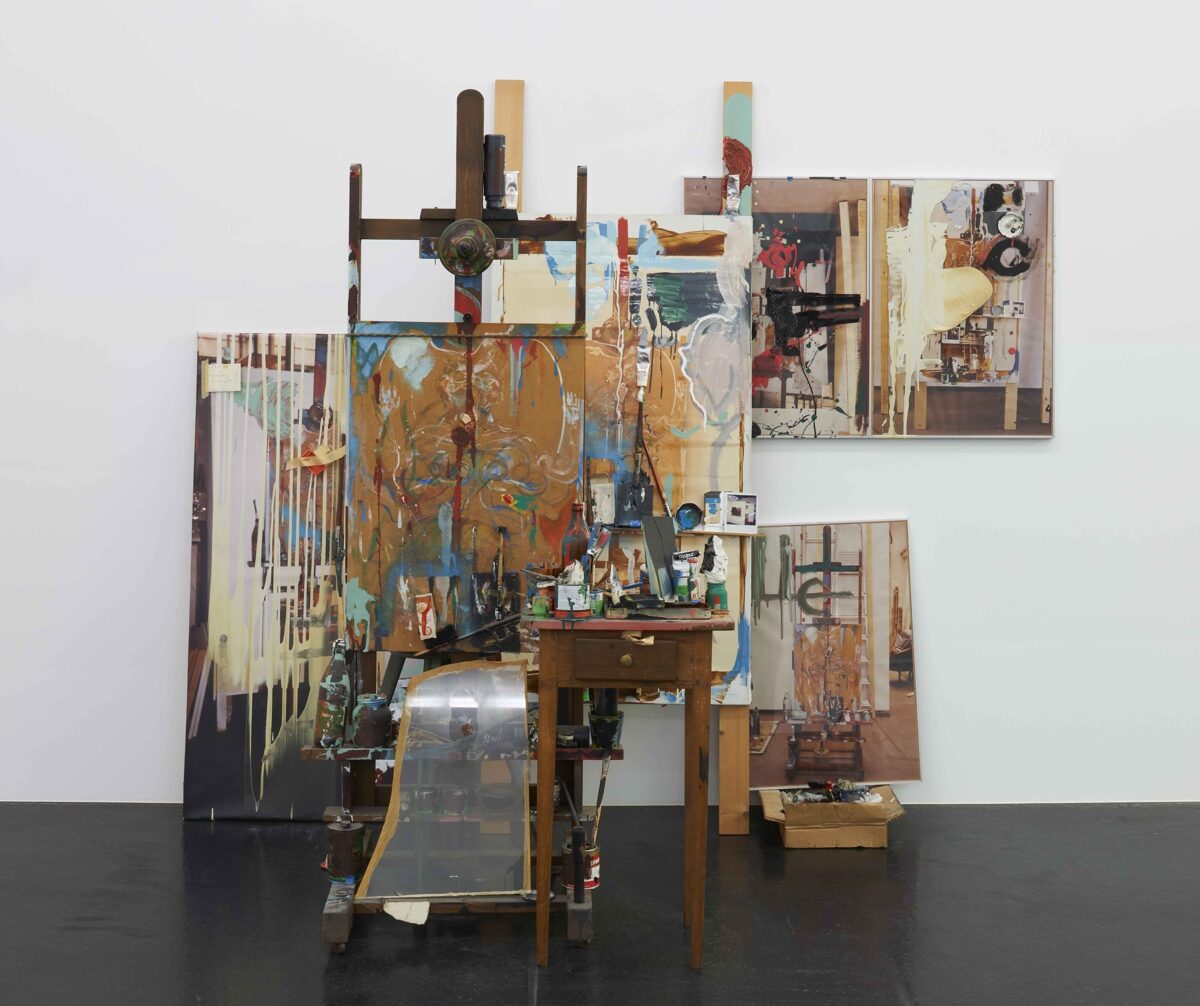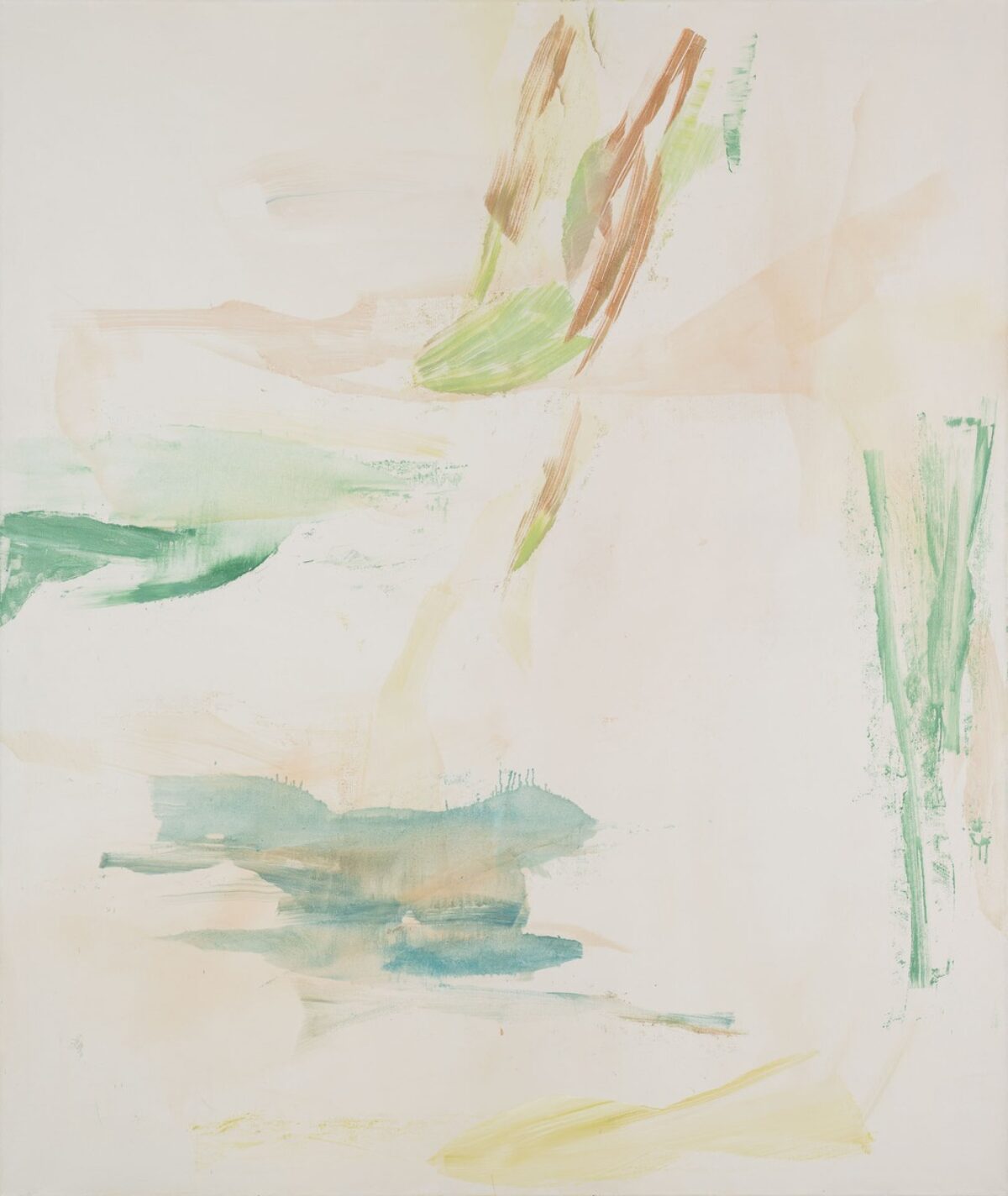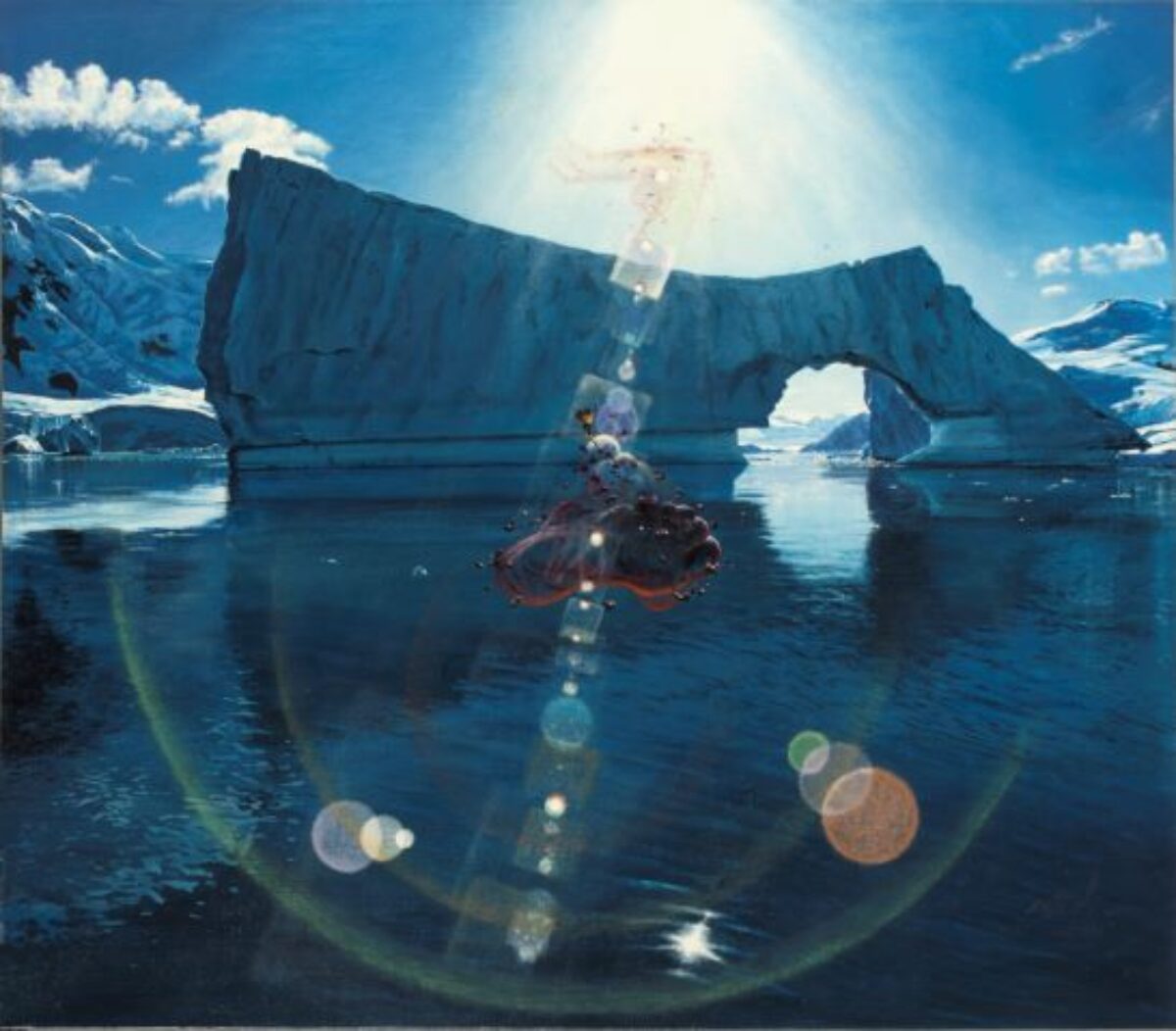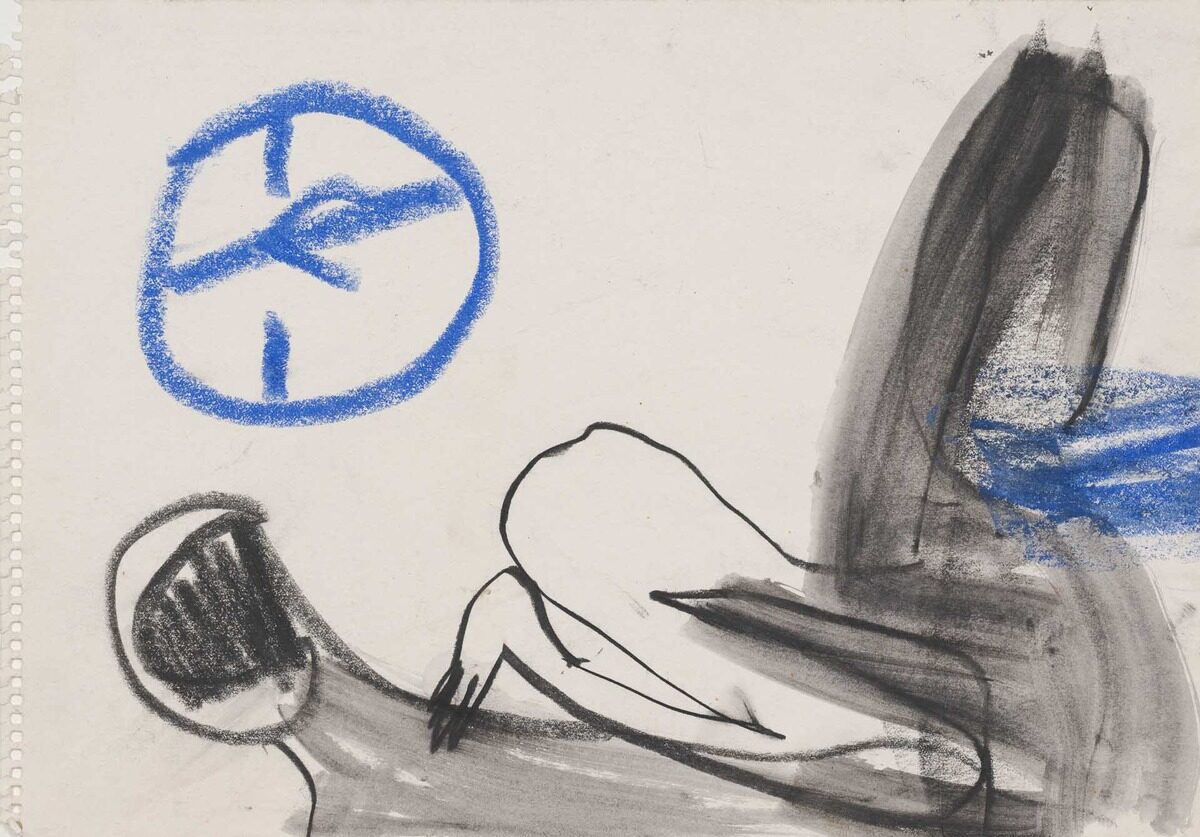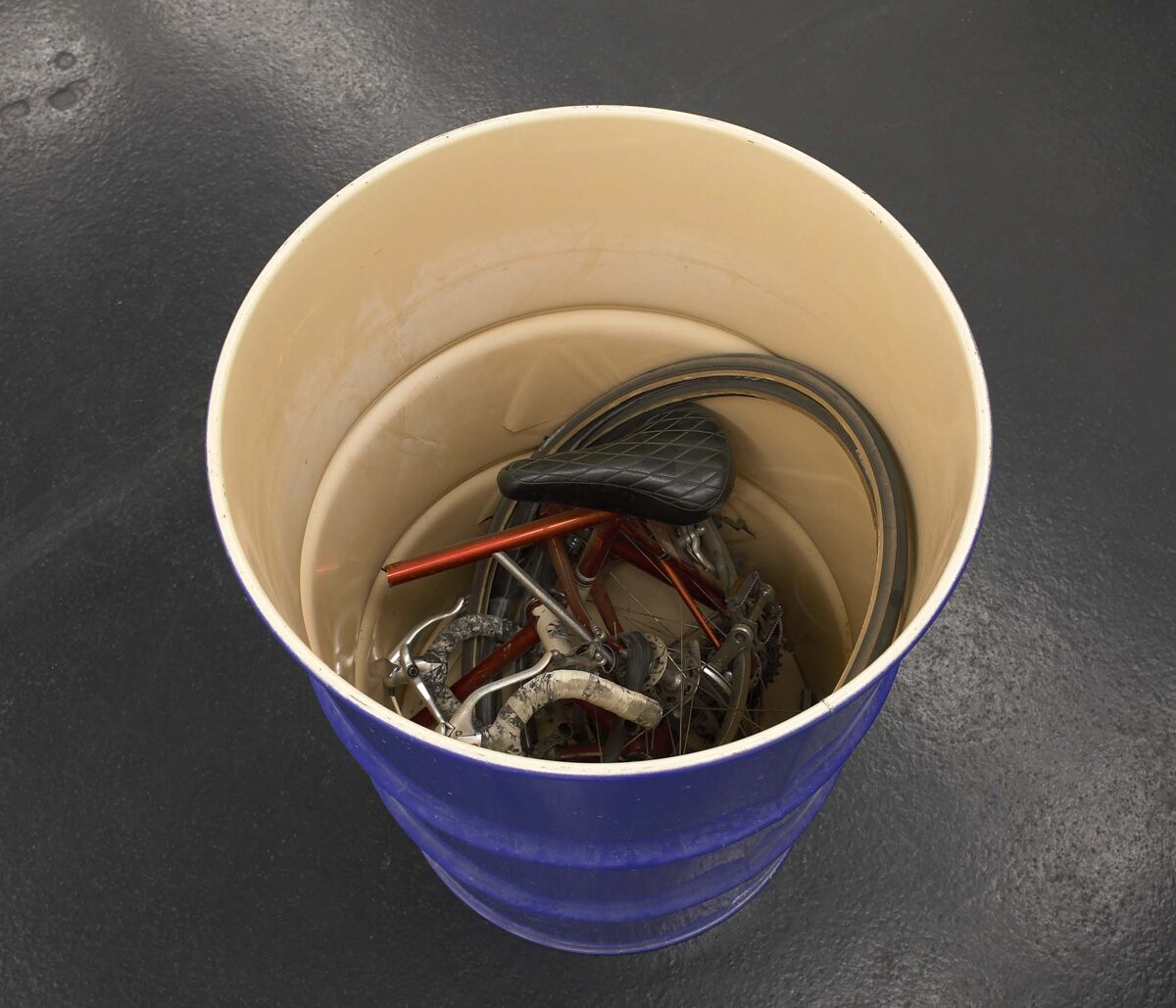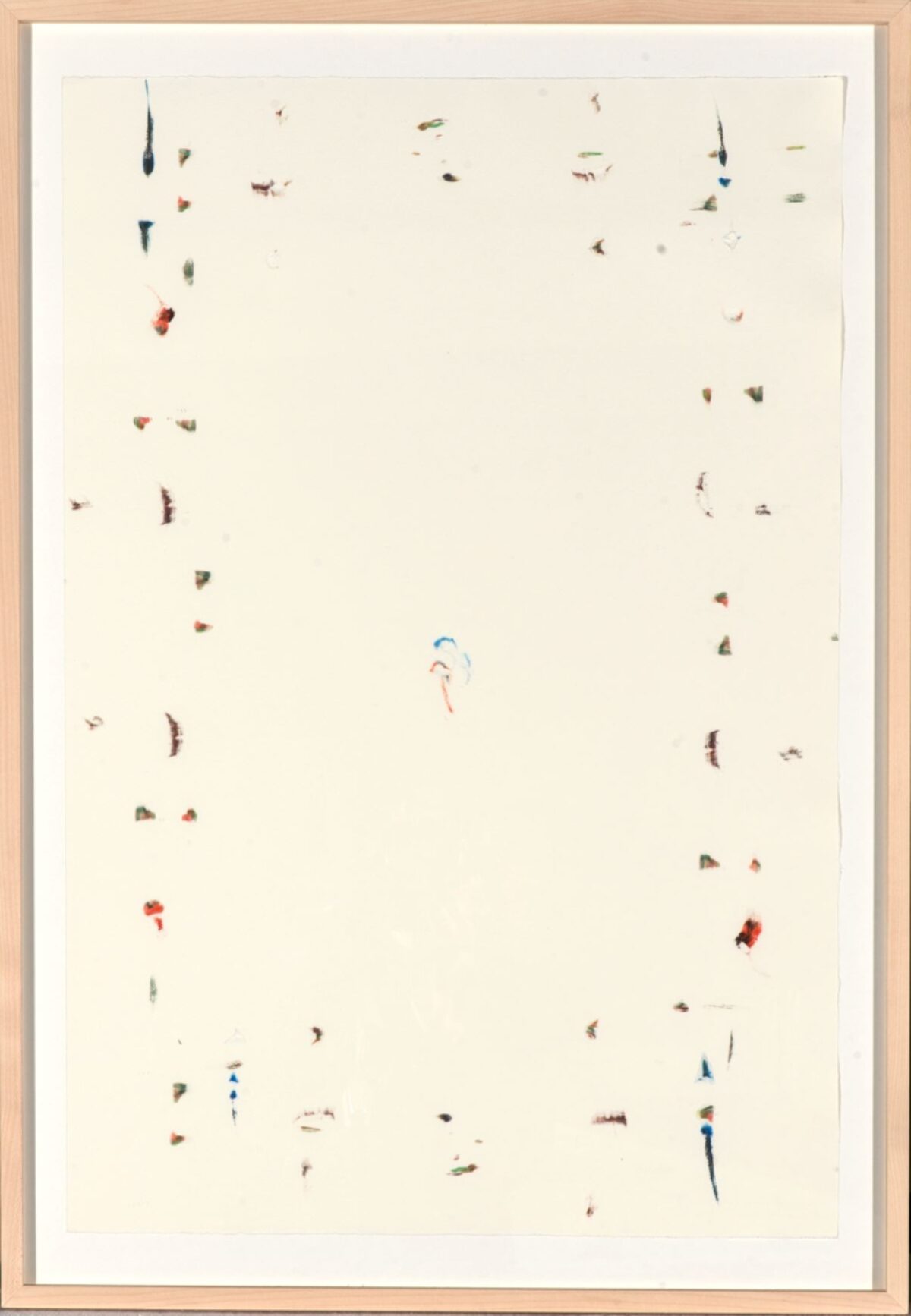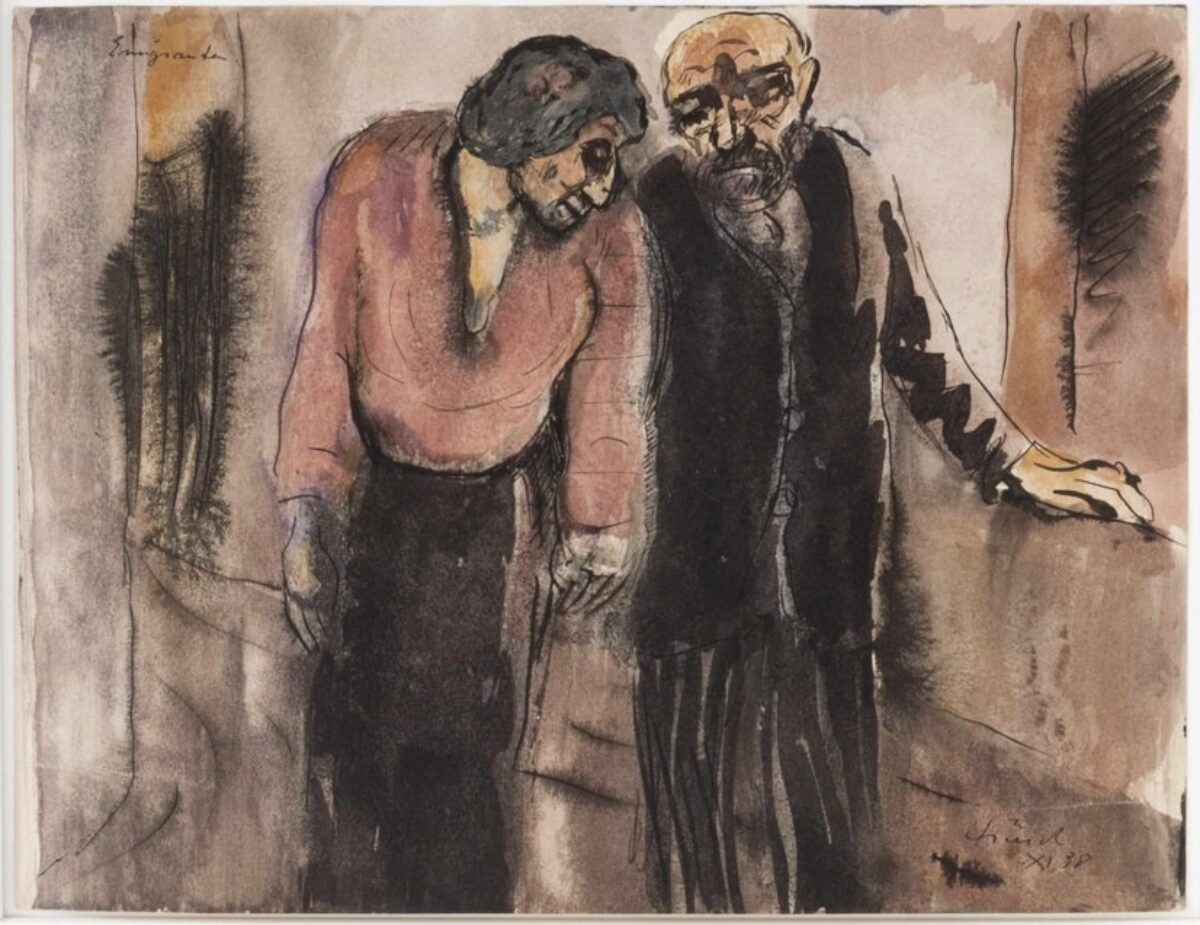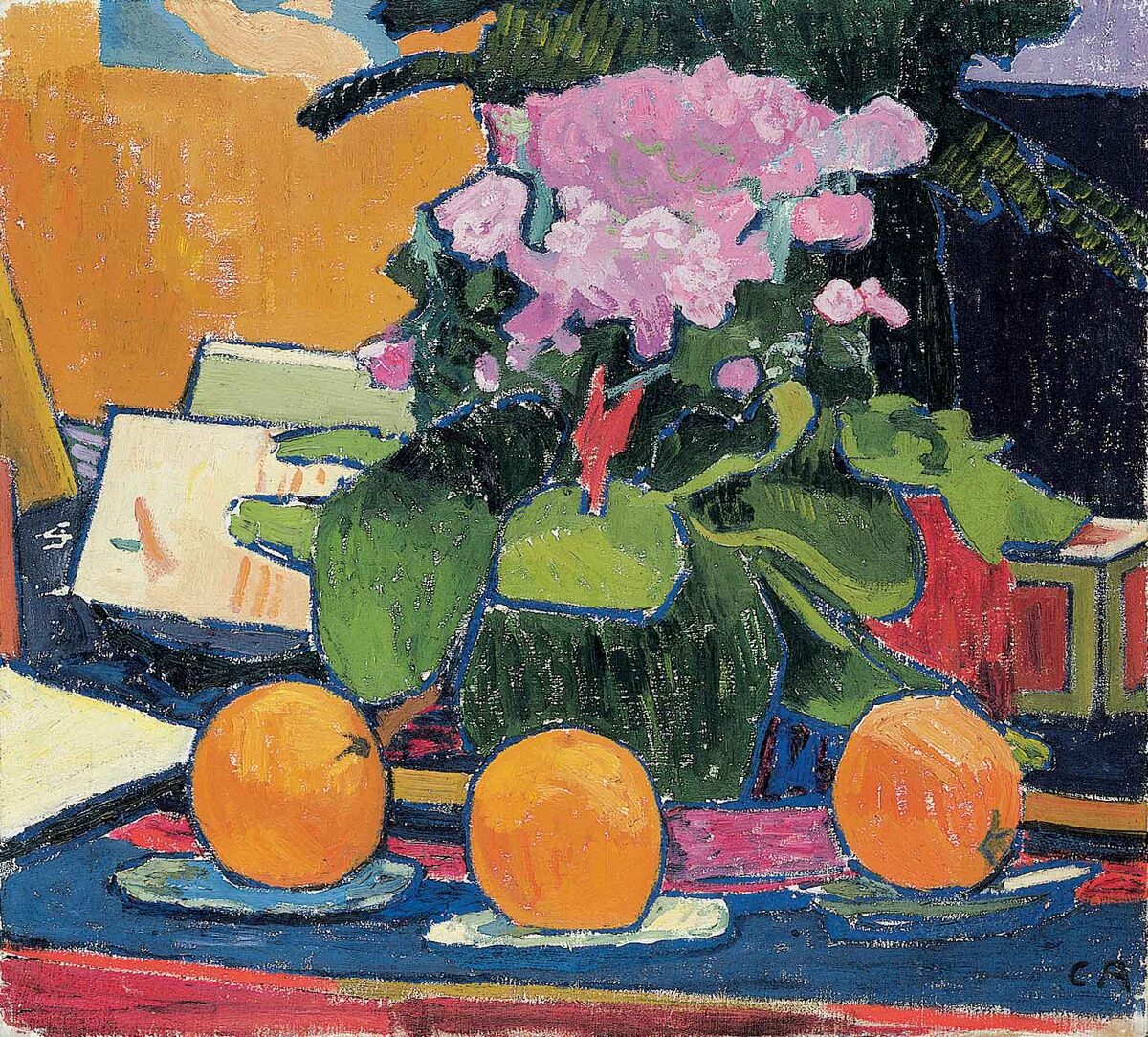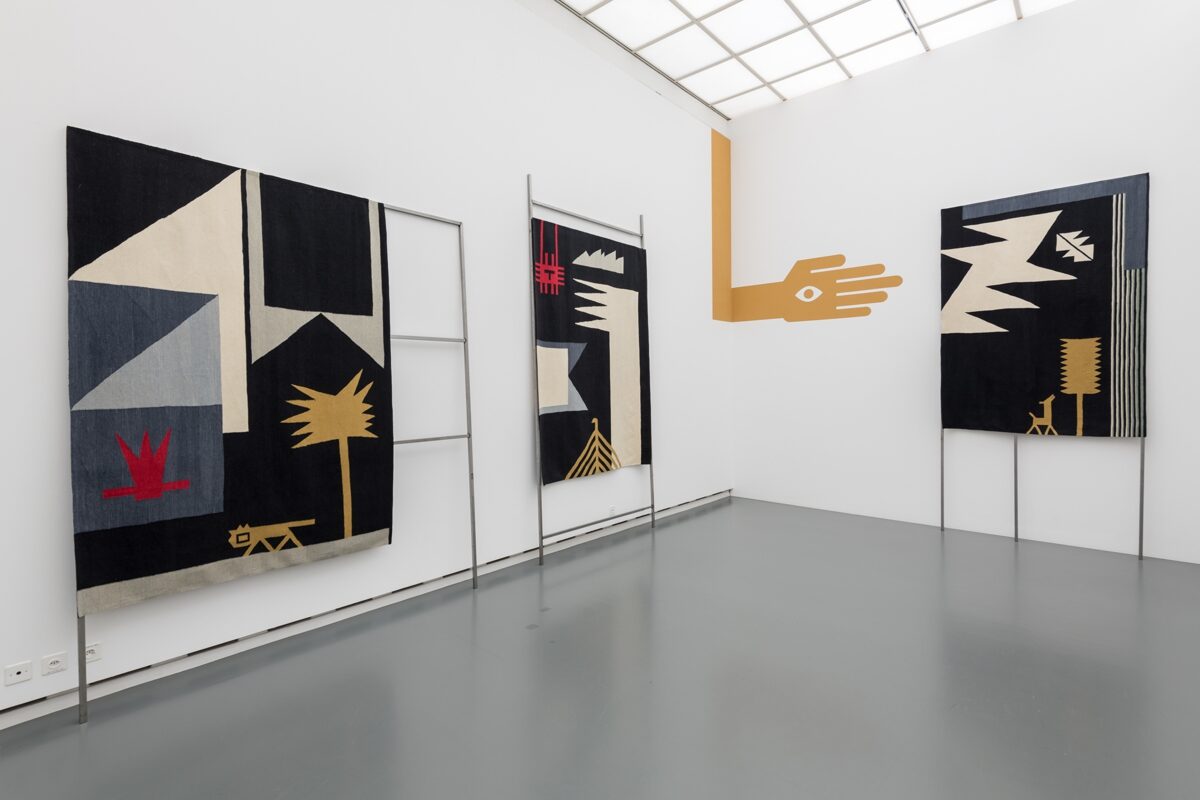
Dispersion auf ungrundiertem Halbleinen, 200 x 300 cm
English, french and italian version below
Der Maler und Holzschneider Franz Gertsch (1930–2022) gehört neben Markus Raetz (1941–2020), zu den international bedeutenden Schweizer Künstlern der Gegenwart. Das grossformatige Gemälde „Kranenburg“ konnte 1994 mithilfe des Lotteriefonds und des gesamten Jahresankaufsetats des Aargauer Kunsthauses aus deutschem Privatbesitz erworben werden. Zusätzlich befinden sich Arbeiten aus Gertschs Pop Art-Periode und aus seinem Spätwerk in der Sammlung.
Nach dem Besuch der Malschule Max von Mühlenen (1903–1971) und dem Studium altmeisterlicher Maltechniken bei Hans Schwarzenbach (1911–1983) beteiligt sich Gertsch an ersten Ausstellungen und ist fortan als professioneller Maler tätig. In den 1960er-Jahren erhält er entscheidende Impulse aus der Pop-Art, die ihm die Möglichkeiten der alltäglichen Motivwelt in der gegenständlichen Malerei offenbart. 1969 findet er sein künstlerisches Konzept, das er seither konsequent verfolgt: die realistische Arbeit nach fotografischen Vorlagen, genauer gesagt nach Diapositiven. Im gleichen Jahr erschafft er mit „Huaa…!“ das erste fotorealistische Bild im Grossformat, das auf der Abbildung einer Filmszene in einer Zeitschrift basiert. Weiter thematisiert Gertsch nacheinander seine Familie, die politische Situation, die Künstlerfreunde.
Die vorliegende Arbeit „Kranenburg“ wird in mehrfacher Hinsicht als Schlüsselbild betrachtet. Einerseits gilt es als erstes Hauptwerk, mit dem Gertsch internationale Beachtung erlangt, andererseits dokumentiert es den Aufbruch der jungen Schweizer Kunstszene um 1970. In Rückansicht hält Gertsch von links nach rechts Markus Raetz, Jean-Christophe Ammann, Monika Raetz, Maria Gertsch, Pablo Stähli, Balthasar Burkhard und den holländischen Theaterpionier Ritsaert ten Cate fest. Sie sind auf dem Weg an die Vernissage der Ausstellung von Franz Eggenschwiler und der „Berner Werkgemeinschaft“ bei den Brüdern van der Grinten in Kranenburg. Gertsch übersetzt das von ihm fotografierte Ereignis in monumentale Malerei: Das Werk weist somit über diese Begebenheit hinaus auf eine künstlerische Szene, die sich damals ausserhalb etablierter Kunstzentren formiert und in der sich Künstler, Museumsleiter und Galeristen zusammen an die Öffentlichkeit wenden.
Konstanten in Gertschs Œuvre bilden Figuration und Präzision. Ausgangspunkt für das Bild ist die Fotografie, mit deren Hilfe er einen bestimmten Moment festhält. Der Künstler fotografiert sein Motiv so oft, bis ihm ein Abbild vorliegt, das seiner Vorstellung einer geeigneten Vorlage entspricht. Im abgedunkelten Atelier malt Gertsch akribisch zonenweise die auf den Bildträger geworfene Diaprojektion. Zunächst arbeitet Gertsch in der Technik der Primamalerei, bei der die Farbe direkt und deckend aufgetragen wird. 1969 entdeckt er bei amerikanischen Malern ein noch direkteres Verfahren, nämlich auf ungrundierten Flächen zu arbeiten. Die gewählte Ausführungssweise ermöglicht Gertsch die wichtige Erfahrung, „dass ich mich durch das Medium der Fotografie auch von einer allzu starken Emotionalität frei machen konnte. Ich konnte gleichsam die Verantwortlichkeit für die dargestellten Dinge ablegen […]“. Der von der Fotografie ausgehende Realismus jedoch verpflichtet ihn nicht zur oberflächlichen Abbildung, sondern er überführt die Aufnahme in eine andere Dimension und verändert die tonale Wertigkeit des Fotos, da es auf dem gemalten Bild keine wichtigen oder unwichtigen Stellen gibt. Gertsch zeigt sich als sensibler Zeitzeuge, der unbefangene Momente persönlicher Begegnungen auswählt und ihre Präsenz durch die Grösse des Bildformats steigert.
Karoliina Elmer
***
The painter and woodcutter Franz Gertsch (1930–2022) is – along with Markus Raetz (1941–2020) – one of the internationally most prominent Swiss artists of our time. In 1994, his large-scale painting “Kranenburg” was acquired from a German private collection with the aid of the Swiss Lottery Fund and the entire annual acquisitions budget of the Aargauer Kunsthaus. The collection also includes works from Gertsch’s Pop art period and examples of his late work.
After attending the painting school of Max von Mühlenen (1903–1971) and studying old-master painting techniques under Hans Schwarzenbach (1911–1983), Gertsch participates in first exhibitions and, from then on, works as a professional painter. In the 1960s, Pop art provided decisive impulses, opening up the possibilities of everyday subjects in representational painting for him. In 1969, he works out his artistic concept which he has been consistently pursuing ever since: realistic work based on photographic sources or, more precisely, transparencies. That same year, he creates his first large-scale, photorealistic painting titled “Huaa…!”, which is based on a film still in a magazine. Gertsch also turns his focus to, successively, his own family, the political situation and artist friends.
“Kranenburg”, the work discussed here, is in many ways considered a key painting. On the one hand, it is regarded as the first major work to earn Gertsch international attention. On the other, it documents the emergence of the young Swiss art scene around 1970. Captured in rear view are, from left to right, Markus Raetz, Jean-Christophe Ammann, Monika Raetz, Maria Gertsch, Pablo Stähli, Balthasar Burkhard and Dutch theatre pioneer Ritsaert ten Cate. They are on the way to the opening of the exhibition of Franz Eggenschwiler and the “Berner Werkgemeinschaft” at the house of the van der Grinten brothers in Kranenburg. Gertsch translates the moment he has photographed into monumental painting; as a result, the work points beyond the particular event to the artistic scene then forming outside established art centres and involving artists, museum directors and gallerists who turn to the public.
Figuration and precision are constants in Gertsch’s oeuvre. Photography is the starting point for the painting, as it serves to capture a particular moment. The artist keeps photographing his subjects until he has an image consistent with his idea of an adequate source. In his darkened studio, Gertsch meticulously paints, zone by zone, the transparency projected onto the painting support. At first, he uses the technique of wet-on-wet painting in which the paint is applied directly in an opaque manner. In 1969, he discovers an even more direct method among American painters: that of working on unprimed surfaces. The chosen manner of execution offers the important insight “that the medium of photography allowed me to free myself from an overly strong emotionality. I was able, as it were, to shed responsibility for the things depicted …”. Yet the realism arising from photography does not oblige him to superficial depiction; instead, he transfers the photographic image into another dimension and changes its tonal values, since there are no important or unimportant areas in the painted picture. Gertsch shows himself to be a sensitive contemporary witness who selects unselfconscious moments of personal encounters and enhances the subject’s presence through the scale of the painting’s dimensions.
Karoliina Elmer
***
Le peintre et xylographe Franz Gertsch (1930-2022) fait partie, avec Markus Raetz (1941-2020), des artistes suisses contemporains de renommée internationale. Le tableau de grand format «Kranenburg» a pu être acheté auprès d’un particulier allemand en 1994 à l’aide du fonds de loterie et de la totalité du budget annuel de l’Aargauer Kunsthaus consacré aux acquisitions. Par ailleurs, nos collections renferment également des œuvres de la période pop art de Gertsch ainsi que de sa période tardive.
Après avoir fréquenté l’école de peinture de Max von Mühlenen (1903-1971) et suivi des études en techniques de peinture des maîtres anciens auprès de Hans Schwarzenbach (1911-1983), Gertsch participe à de premières expositions et travaille dès lors comme artiste peintre professionnel. Les années 1960 lui donnent une impulsion décisive avec le pop art, en lui faisant découvrir les possibilités qu’offre l’univers des motifs issus du quotidien dans la peinture figurative. En 1969, il trouve son concept artistique auquel il est depuis resté fidèle sans concession: le travail réaliste à partir de photographies, ou plus exactement de diapositives. La même année, il crée avec «Huaa…!», le premier tableau photoréaliste en grand format, qui se base sur l’illustration d’une scène de film dans un magazine. Gertsch thématise également tour à tour sa famille, la situation politique, les amis artistes.
Le présent travail «Kranenburg» fait figure, à bien des points de vue, de tableau-clé. D’une part, il est considéré comme la première œuvre importante ayant permis à Gertsch d’acquérir une reconnaissance internationale; d’autre part il documente le renouveau de la jeune scène artistique suisse vers 1970. Gertsch immortalise, de gauche à droite et vus de dos, Markus Raetz, Jean-Christophe Ammann, Monika Raetz, Maria Gertsch, Pablo Stähli, Balthasar Burkhard et le pionnier et artiste visuel néerlandais Ritsaert ten Cate. Ils se rendent au vernissage de l’exposition de Franz Eggenschwiler et de la «Berner Werkgemeinschaft» chez les frères van der Grinten à Kranenburg. Gertsch traduit l’évènement qu’il a photographié lui-même en une peinture monumentale: au-delà de la situation, l’œuvre fait référence à une scène artistique qui se forme à l’époque en dehors des centres établis et où artistes, directeurs de musée et galeristes s’adressent ensemble au public.
La figuration et la précision constituent des constantes dans l’œuvre de Gertsch. Le point de départ pour le tableau est la photographie à l’aide de laquelle il immortalise un moment précis. L’artiste photographie son motif jusqu’à ce qu’il ait une image qu’il considère être un modèle approprié. Dans son atelier obscurci, Gertsch peint avec minutie, zone après zone, la diapositive projetée sur le support de peinture. Au début, Gertsch travaille selon la technique alla prima, qui consiste à couvrir la toile par l’application directe d’une seule couche de peinture. En 1969, il découvre chez les peintres américains un procédé encore plus direct, à savoir travailler sur des surfaces non apprêtées. Le mode d’exécution choisi permet à Gertsch de faire l’expérience capitale «que je pouvais, grâce au médium de la photographie, me libérer également d’une émotivité par trop puissante. Je pouvais en quelque sorte me défaire de la responsabilité pour la chose représentée […]». Cependant, le réalisme émanant de la photographie ne l’astreint pas à une représentation superficielle; il transpose au contraire le cliché dans une autre dimension et modifie la valeur tonale de la photo, puisqu’il n’y a pas de zones importantes ou sans importance sur l’image peinte. Gertsch apparaît comme un témoin sensible de son temps, qui choisit des moments informels de rencontres personnelles et accroît leur présence par la taille du format de tableau choisi.
Karoliina Elmer
***
Insieme a Markus Raetz (1941-2020), il pittore e xilografo Franz Gertsch (1930-2022) è tra i più significativi artisti svizzeri contemporanei di fama internazionale. Il quadro di grande formato intitolato “Kranenburg” è stato acquistato dall’Aargauer Kunsthaus nel 1994 da una collezione privata tedesca, con l’aiuto del fondo della lotteria e con l’intero fondo annuale di acquisizione del museo. La collezione dell’Aargauer Kunsthaus include anche opere di Gertsch risalenti ai periodi della Pop Art e della maturità.
Dopo la formazione alla scuola di pittura di Max von Mühlenen (1903-1971) e dopo aver studiato le tecniche pittoriche degli antichi maestri con Hans Schwarzenbach (1911-1983), Gertsch partecipa alle prime esposizioni e si dedica esclusivamente alla pittura. Negli anni Sessanta riceve impulsi decisivi dalla Pop Art, che gli rivela il potenziale iconografico del mondo quotidiano per la pittura figurativa. Nel 1969 matura la sua concezione artistica, perseguita con coerenza fino a oggi, fondata sulla rappresentazione realistica a partire da modelli fotografici, o meglio da diapositive. Nello stesso anno realizza “Huaa…!”, il primo quadro fotorealista di grande formato, realizzato a partire dalla riproduzione di una scena cinematografica prelevata da una rivista. In seguito, Gertsch sceglie i temi dei suoi lavori nella propria famiglia, nella situazione politica e tra gli amici artisti.
“Kranenburg” può essere considerata un’opera di particolare rilievo sotto più aspetti. Anzitutto è il primo quadro importante di Gertsch, con il quale acquista notorietà internazionale; in secondo luogo documenta l’affermazione della giovane scena artistica svizzera intorno al 1970. Da sinistra verso destra, Gertsch raffigura di spalle Markus Raetz, Jean-Christophe Ammann, Monika Raetz, Maria Gertsch, Pablo Stähli, Balthasar Burkhard e il pioniere del teatro sperimentale olandese Ritsaert ten Cate. Il gruppo è diretto all’inaugurazione dell’esposizione di Franz Eggenschwiler e della “Berner Werkgemeinschaft” presso i fratelli van der Grinten a Kranenburg. Gertsch trascrive il suo scatto fotografico in un quadro monumentale, che trascende l’evento contingente e rinvia a una scena artistica all’epoca in pieno fermento, al di fuori dei centri principali, nella quale artisti, direttori di museo e galleristi si rivolgono congiuntamente al pubblico.
Nel lavoro di Gertsch vi sono due costanti: la figurazione e la precisione. Punto di partenza per il quadro è la fotografia, che serve per fissare un determinato istante. L’artista fotografa ripetutamente il motivo scelto, fino a ottenere una riproduzione che corrisponde al modello immaginato. Nell’atelier oscurato, Gertsch dipinge meticolosamente, procedendo per zone, l’immagine proiettata dal diaproiettore sulla superficie di supporto. In un primo tempo lavora con la tecnica pittorica alla prima, nella quale il colore viene applicato direttamente e a più strati. Nel 1969 scopre nei pittori americani un procedimento ancora più diretto, ossia la stesura del colore su un supporto grezzo. Grazie alla nuova tecnica approda a un’esperienza di svolta: capisce cioè che “attraverso il mezzo fotografico potevo liberarmi anche da un’emotività eccessiva. Nello stesso tempo mi sentivo esonerato dalla responsabilità per i soggetti rappresentati […]”. Il realismo basato sulla fotografia non limita però l’artista a una riproduzione superficiale, ma, al contrario, gli permette di trascrivere l’immagine in un’altra dimensione e di trasformare la valenza tonale della fotografia, dato che nel quadro dipinto non esiste la distinzione tra aree rilevanti e irrilevanti. Testimone sensibile del suo tempo, Gertsch sceglie momenti disinvolti di incontri personali e ne intensifica la presenza attraverso la trasposizione in quadri di grande formato.
Karoliina Elmer

